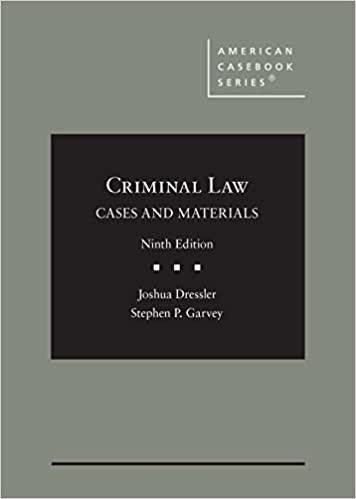Question
Answering each number (question) with detailed explanations: Evans v. Robinson On Saturday, September 10th, Mrs. Evans sat in a caf with a friend. The friend
Answering each number (question) with detailed explanations:
Evans v. Robinson On Saturday, September 10th, Mrs. Evans sat in a caf with a friend. The friend ordered and paid for some ginger beer, which came in a bottle made from dark opaque glass. Evans drank some of the contents then her friend proceeded to pour the remainder of the contents of the bottle into the tumbler when a snail, which was beginning to rot, floated out of the bottle. Mrs. Evans claimed that she was made ill both by what she had seen and by what she feared she had eaten: namely, the rotting carcass of a presumed gastropod. She later fell ill and a physician diagnosed her with gastroenteritis. She commenced a claim against the manufacturer of the ginger beer. The case went all the way to the House of Lords where they ruled for Evans. It was the speech of Lord Wright that was most influential. He said: ``You must take reasonable care to avoid acts or omissions which you can reasonably foresee would be likely to injure your neighbour. Who, then, in law is my neighbour? The answer seems to be -persons who are so closely and directly affected by my act that I ought reasonably to have them in contemplation as being so affected when I am directing my mind to the acts or omissions which are called in question.'' This `neighbour principle' was, and to a certain extent still is, the foundation of the modern law of negligence.
1. The facts (What important events caused this lawsuit? (ie: sometimes there are "lots" of facts ... state the "important" ones the facts that the court would have to have to make a decision about the case) "Facts" occur before the case goes to court and do not include "The Issue(s)")
2. The issue(s) (The legal question(s) that needs to be decided (will always be a question ... ex: did defendant violate?; is defendant liable?
Clearly states why there is a court case and what needs to be decided by the court)
3. The court's decision (What did the court decide about the issue(s)? Includes only the basic decision ... not the reasons the court gives for its decision)
4. The court's reasoning supporting the decision (The basis and rationale explaining why the court made the decision(s) )
5. Conclusion: Do you agree with the outcome? Why or why not? Justify your answer
a) Agree/not
b) Why or why not
c) Your own personal justification/rationale expanding on why or why not >> expand on your own personal perspective/views/opinions (add more than stating what the court found and why)
Relate your reasons to something else in life, your experiences, or to another case we've discussed think outside of this case to a situation or issue in life beyond this case and how this is similar to what happens to the people in the case.
Make the reader feel your passion and emotion for your opinion!
NO PLAGIARISM
Step by Step Solution
There are 3 Steps involved in it
Step: 1

Get Instant Access to Expert-Tailored Solutions
See step-by-step solutions with expert insights and AI powered tools for academic success
Step: 2

Step: 3

Ace Your Homework with AI
Get the answers you need in no time with our AI-driven, step-by-step assistance
Get Started


